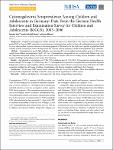Cytomegalovirus Seroprevalence Among Children and Adolescents in Germany: Data From the German Health Interview and Examination Survey for Children and Adolescents (KiGGS), 2003–2006
Voigt, Sebastian
Rosario, Angelika Schaffrath
Mankertz, Annette
Background. Congenital cytomegalovirus (CMV) infection can cause severe birth defects. The majority of children with congenital CMV are born to CMV-seropositive women; however, transmission from mother to fetus and resulting defects are more likely to occur when mothers experience seroconversion during pregnancy. The objective of this study was to provide a population-based estimate of CMV seropositivity and to identify factors that correlate with the detection of CMV-immunoglobulin (Ig)G antibodies. Methods. Cytomegalovirus-specific IgG antibodies were determined by enzyme-linked immunosorbent assay in 13 876 serum samples from children and adolescents (aged 1–17 years). Cytomegalovirus seroprevalence was correlated with children's age, gender, migration background, country of origin, place of birth, socioeconomic status, breast feeding, daycare attendance, order and number of siblings, and residence in East versus West Germany. Results. Age-adjusted seroprevalence was 27.4% (95% confidence interval, 25.8–29.0). Cytomegalovirus seroprevalence increased with age (21.5% at ages 1–2; 32.0% at ages 14–17). Cytomegalovirus seropositivity was significantly associated with migration background, country of origin and place of birth, and (among migrants only) with low socioeconomic status. Risk factors for CMV acquisition included the birth order of siblings, breastfeeding, early daycare attendance, and living in East Germany. Conclusions. In Germany, CMV seroprevalence increases with age, irrespective of gender. These data highlight risk factors associated with seroprevalence and help to identify a target age for the application of a CMV vaccine.
Dateien zu dieser Publikation
Keine Lizenzangabe

